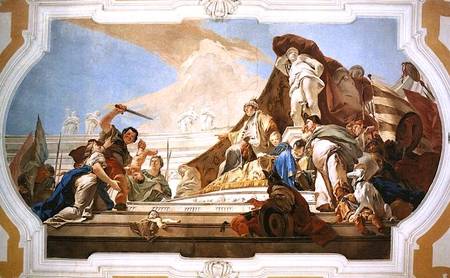by Charles Freeman
At the end of a recent tour of Friuli in October, I asked members of my group what they had enjoyed most, High on the list were the Tiepolos in the Patriarchal Palace in Udine. Commissioned in the 1720s by the Patriarch of Aquileia, Dionisio Dolfin, member of an aristocratic Venetian family, they were designed to highlight the link between the Patriarch and the patriarchs of old, Abraham, Isaac and Jacob. Perhaps the two finest works are Rachel hiding the idols from her father, Laban, and The Judgement of Solomon. Their state of preservation is remarkable.

Tiepolo was still young, just thirty, when he began his commission, but already his work is assured. The colours are rich, the soaring perspectives painted with the confidence that was to stay with him throughout his Europe-wide career. He always comes across to me as someone who loved painting for its own sake, not as a means of sorting out some internal angst.
So it was frustrating to arrive at our next destination, the vast Villa Manin, and to find that we were a few weeks too early to see the majestic Tiepolo exhibition that opened there on 15 December (and lasts until 7 April). It is open every day, even on the afternoon of Christmas day (further information and booking on the Villa Manin website).
The exhibition boasts a wide scope. There are works from Venice and the villas of the Venetian countryside, where Tiepolo spent much of his life, many of which have been brought back from the galleries as far flung as new York, Montreal, Helsinki and Stockholm. Several of the canvases are enormous—luckily the central rooms of the Villa Manin can take them—together with the preparatory drawings for them. So the vast canvas (7m by 4m) of St Thecla freeing the city of Este from the plague, from Este cathedral (completed in 1759 in commemoration of a plague of 1638) is there together with the preparatory study now in the Metropolitan Museum in New York. The opportunity has been taken to restore the canvas: in fact there is a sense of opulent generosity about this exhibition that is far removed from the austerity that is afflicting so many Italian archaeological sites at the moment.
The exhibition is linked to the Patriarchal Palace in Udine and the Sartorio Museum in Trieste, which contains a fine cache of Tiepolo drawings. So the show promises a true feast for those who find themselves drawn to an artist who is perhaps the finest Italian painter of the 18th century.
Udine and Friuli are covered in Blue Guide Northern Italy and Blue Guide Concise Italy. Charles Freeman is historical consultant to the Blue Guides and author of Sites of Antiquity: 50 Sites that Explain the Classical World.






